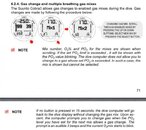DevonDiver
N/A
I've owned and used Suunto products for many years. My first computer was an 'Eon', followed by a Vyper and a D9. I still use the Vyper primarily... it's the epitome of a rugged, reliable computer that does everything you need a dive computer to do (10+ years and mine's still going strong).
Feeback:
1) Straps on new models remain an issue. The computers aren't compatible with regular watch straps - which comes across as cynical. The rubber straps have a very short lifespan - and do not reflect the good quality that one otherwise expects from Suunto. My D9 strap survived for about 9 months of light use - very disappointing, especially considering the cost of replacements.
2) A stopwatch function would be invaluable for professional level divers. Ideally, it would be accessible in conjunction with regular dive functions. For instance, when dive instructors need to time 30 seconds, or 2 minutes, accurately when assessing diver skills in training.
3) The Suunto Gekko doesn't have a bottom timer function. If it did, I would recommend it in virtually every instance as an entry-level computer. The lack of bottom timer makes it unusable for many training courses, especially technical diving, where tables are used. Likewise, it hinders those instructors who wish to teach the use of tables, in conjunction/addition to dive computer use. Put a bottom timer function on the Gekko and it'd be close to the perfect recreational diving computer...
4) D9tx and HelO2 are over-priced in comparison with some of their competition IMHO. They lack certain features (such as rechargeable, oLED color display, user chosen firm/software etc) in that price bracket.
5) Suunto dive alarm functions are too high pitched. I have high-end hearing loss from my military service. I can hear other dive computer alarms, but cannot hear alarms on Suunto computers.
6) Bungee-type arm mounts are very common and popular now. Suunto are missing a trick by not offering these as an option/standard with their computers.
Hope that helps.
Feeback:
1) Straps on new models remain an issue. The computers aren't compatible with regular watch straps - which comes across as cynical. The rubber straps have a very short lifespan - and do not reflect the good quality that one otherwise expects from Suunto. My D9 strap survived for about 9 months of light use - very disappointing, especially considering the cost of replacements.
2) A stopwatch function would be invaluable for professional level divers. Ideally, it would be accessible in conjunction with regular dive functions. For instance, when dive instructors need to time 30 seconds, or 2 minutes, accurately when assessing diver skills in training.
3) The Suunto Gekko doesn't have a bottom timer function. If it did, I would recommend it in virtually every instance as an entry-level computer. The lack of bottom timer makes it unusable for many training courses, especially technical diving, where tables are used. Likewise, it hinders those instructors who wish to teach the use of tables, in conjunction/addition to dive computer use. Put a bottom timer function on the Gekko and it'd be close to the perfect recreational diving computer...
4) D9tx and HelO2 are over-priced in comparison with some of their competition IMHO. They lack certain features (such as rechargeable, oLED color display, user chosen firm/software etc) in that price bracket.
5) Suunto dive alarm functions are too high pitched. I have high-end hearing loss from my military service. I can hear other dive computer alarms, but cannot hear alarms on Suunto computers.
6) Bungee-type arm mounts are very common and popular now. Suunto are missing a trick by not offering these as an option/standard with their computers.
Hope that helps.




